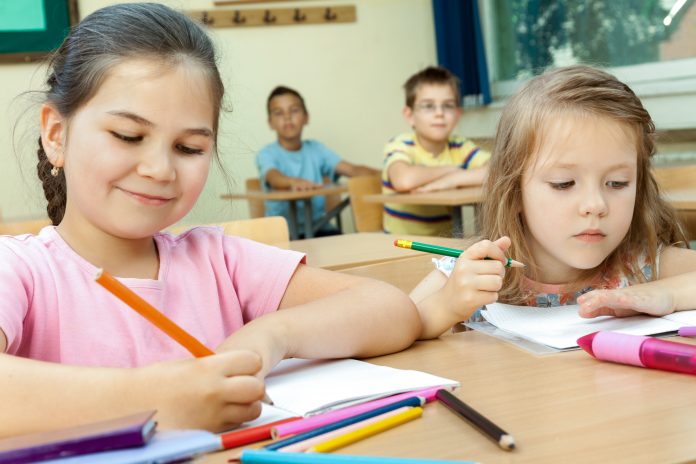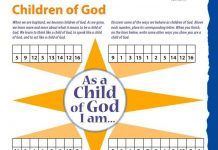
by Renée McAlister and Julie Brunet
Find “Teaching Tips for Working with Young Children” at the end of this article.
Young children learn by doing and are eager to be involved in the learning process. According to the National Association of Elementary School Principals, “Children in the three-to-eight-year range acquire knowledge in ways that are significantly different from the ways older children learn. Younger children learn best through best through direct sensory encounters with the world and not through formal academic processes…. Young children acquire knowledge by manipulating, exploring, and experimenting with real objects. They learn almost exclusively by doing and through movement.”
Wonder and Curiosity
Children have a natural sense of wonder and curiosity. This sense of curiosity compels their desire to learn about self and the world. Young children also have short attention spans. They have boundless energy and, because they are eager to move, young children are unable to sit for long periods of time. Large motor skills are developing rapidly, allowing children to run, jump, hop, and skip. Small motor skills are developing much more slowly, causing the use of crayons, pencils, and scissors to be more challenging for young children.
Young children begin to leave the parallel play stage and gradually shift to cooperative play. They are somewhat reluctant to share. They enjoy dramatic play, puppets, fantasy, stories, music and rhythms, repetition in songs, and finger plays. Musical experiences are enhanced when movement and motions are added.
Self-Expression
Language develops very rapidly during the early childhood years. Children move from speaking in simple sentences to using language for self-expression, for interaction with others, and for obtaining what they want. As language development continues, children are able to give expression to their thoughts, wants, fears, and feelings. They take words and phrases literally and have trouble understanding and grasping abstract concepts.
Young children are beginning to know the difference between acceptable and unacceptable behavior and are concerned with cause-and-effect relationships. Rules provide structure and can be understood and followed. Young children are reluctant to tolerate others breaking the rules.
Classroom routines help young children feel secure and provide boundaries. A regular routine provides them a sense of time as they learn what comes first, second, and last during their day. When the daily schedule is consistent, young children have a sense of control over their environment, fostering and building trust.
A Vital Time
The early childhood years are considered vital in the development of children’s social, emotional, physical, cognitive, and language skills. Also of importance at this time is the development of children’s foundation of faith and spirituality.
“Infancy and childhood…are a time of primary socialization as well as of human and Christian education in the family, the school, and the Church. These must then be understood as a decisive moment for the subsequent stages of faith” (General Directory for Catechesis, n. 178).
Early Childhood Religious Formation Programs
Children’s foundation of faith and spirituality can be enhanced and positively impacted by high-quality early childhood religious formation programs. What are the characteristics of a quality early childhood religious formation program?
There are three major components of early childhood religious formation programs: environment, curriculum and materials used, and staff.
Environment
According to the National Association for the Education of Young Children, “The quality of the physical space and materials provided affects the level of involvement of the children and the quality of interaction between adults and children.”
Décor: The décor should be bright and colorful and aesthetically pleasing and inviting to young children. Bulletin boards should be used for displaying the children’s work. Ideally, bulletin boards would be at an appropriate level for young children and be interactive, allowing children to have input in the décor of the room. Bulletin boards can also be progressive in nature, adding components as the year unfolds.
Learning centers: The environment can be divided into learning areas or centers, providing opportunities for young children to explore. Young children learn best in environments that are safe, friendly, and welcoming. Safety must be the initial concern. Only materials that are age-appropriate should be available to children.
Materials with small parts and sharp points should never be used in an early childhood setting. The furniture, such as tables and chairs, should be sized appropriately for the children and should be sturdy and comfortable. Manipulatives, books, and other learning materials should be easily accessible to children.
Designated areas: Group learning is a major part of early childhood religious formation; therefore, an area such as a large space on the floor should be selected for group gatherings. Every classroom should have a designated area that includes a prayer table and a spiritual bulletin board. A children’s Bible, a crucifix, statues of saints, etc., may be placed on the prayer table. The prayer table can be used to enhance the theme of the lessons by garnishing it with items appropriate to the lessons as they are taught.
As space allows, other areas can be part of the classroom, including a quiet area with religious picture books for individual time; a manipulative area where story boards, saints statues, and other religious articles are available for exploration; an art area with various age-appropriate art supplies that are accessible for creative expression; a drama area for role-playing situations with family and friends; and a music area for personal listening.
Child-teacher ratio: The size of the class and, in particular, the child-teacher ratio are important considerations in early childhood religious formation programs. The younger the children, the smaller the class size and child-teacher ratio should be. This will ensure that each child receives adequate time, attention, and personal interaction with the adult in charge. If children are not provided with ample opportunities to relate to the teacher, the benefits of the teacher’s expertise and influence are limited. Additional staff members can help lower the child-teacher ratio and enable more flexibility in the classroom.
Curriculum
Parents provide the first faith community for their children, modeled through their attitudes and beliefs. A quality early childhood religious formation curriculum should continue to build upon this foundation of faith begun by parents as the first catechists in their children’s lives. To achieve this, a quality early childhood religious formation program will include parent involvement—inviting and encouraging parents to remain partners in the continuing religious formation of their children.
Doctrinal content: The doctrinal content of the religious formation curriculum should be explicit and faithful to the Catechism of the Catholic Church. It should be presented in language the young child can understand.
Life experiences: Young children are very egocentric. To have meaning and relevance, the concepts taught in the religious formation classroom must be linked to the real-life experiences of the young children. Children are concrete learners and thinkers. The world of faith and religion are very abstract. A good religious formation curriculum will provide a connection between the lessons of faith and the young children’s daily experiences.
Sensory experiences: Young children are sensory learners. They learn through seeing, hearing, tasting, touching, and hands-on experiences. Therefore a variety of sensory experiences should be part of every lesson. Because young children have short attention spans, the curriculum should provide frequent changes in the methods of presentation. This can include sitting as a whole group for a story, singing through the story, marching to tables, and individually creating an appropriate piece of art.
Prayer and worship experiences: A good religious formation curriculum will include prayer and worship experiences that engage the children. As children are introduced to God’s love through these experiences, they develop personal relationships with God. Additionally, the curriculum should teach the message of Jesus through age-appropriate Scripture stories and experiences. “Central aspects of the formation of children are training in prayer and introduction to Sacred Scripture” (General Directory for Catechesis, n. 178; Directory for Masses with Children, n. 66).
Methodologies, activities, appearance: Young children have different styles of learning. A good religious formation curriculum will provide different methodologies and activities in presenting information to children. When a variety of teaching styles are used, more children will be able to learn and understand the lesson.
Another consideration when selecting a religious formation curriculum is the overall appearance of the program. The materials should be colorful, engaging, and aesthetically appealing. Graphics should include good Christian art, exposing young children to the many beautiful and various kinds of expressions of sacred art. Graphics should also include pictures of real people, places, and things as well as drawings and sketches. Cultural awareness of different ethnic groups should be evidenced.
The curriculum materials should be child-friendly as well as teacher-friendly. The catechist component should be easy to follow. Everything in the lesson should be explained, providing specific steps for the catechist to follow. The goals and objectives of each lesson should be clearly stated. Lesson plans should include a list of materials that will be needed to teach the lesson, additional resources to enhance the lesson, and hands-on activities to help the lesson have meaning for the young child. Professional development and background information for the catechist should be included and easily accessible.
Staff
Early childhood religious formation programs are only going to be as good as the catechists and staff that present the curriculum. The success of a program is directly related to the effectiveness of the staff.
As described previously, young children are unique and learn differently than older children. Therefore, catechists should possess certain characteristics and qualities to be effective in the early childhood classroom. Teachers of young children should have some training and knowledge in the principles of child development and learning. Being aware of how young children develop and learn enables teachers to plan effective and age-appropriate lessons.
Some qualities of effective early childhood teachers and catechists include: a passion for teaching; patience; flexibility; creativity; a love of learning; integrity; high energy; and a sense of humor.
A passion for teaching: Early childhood teachers and catechists must love to work with young children. They must be enthusiastic about their mission to continue the faith development of young children. Educating young children is not always an easy task. It is the passion for teaching that will enable success.
Patience: Effective teaching requires patience. Early childhood lessons often do not go as planned; patience enables the teacher to regard this as a challenge rather than as a failure. Patience helps to dissipate anger and frustration when things don’t go as predicted.
Flexibility: Early childhood education demands that teachers be able to deal with change and unexpected events and situations. Teachers and catechists of young children should be able to change and adapt at a moment’s notice and find alternative solutions to problems that arise.
Creativity: Creativity is a necessary trait for teaching young children. Early childhood teachers and catechists must be able to develop new activities, strategies, and solutions for learning. Creative people often think “outside the box,” enabling many possibilities to otherwise hopeless situations as well as new ways to approach things.
A love of learning: Teachers and catechists must model a love of learning in order to inspire this characteristic in the young children they teach. By being lifelong learners, teachers convey that learning is an important part of life. By modeling a desire to learn more about their faith, catechists pass on this same desire to their young students.
Integrity: Teachers and catechists who posses this quality know who they are and what they stand for. They are authentic and real. Young children easily sense when someone is honest about who they; the children respond accordingly.
High energy: Young children are captivated by teachers and catechists with high energy levels. Children value and are attracted to teachers with high energy.
Sense of humor: Learning should be fun and enjoyable. Laughter dissipates stress and frustration. Teachers and catechists must be able to laugh, even at their own expense.
Conclusion
Jesus came to share and model the Good News of God’s love of all people. The Church continues this mission today. Through caring and concern for the young children entrusted to them, catechists take an integral part in this mission. As they impart the Good News of Jesus’ Resurrection and his continued presence in the life of each young child, catechists bring Jesus’ proclamation into reality: “Let the children come to me, and do not prevent them; for the kingdom of heaven belongs to such as these” (Matthew 19:14; Mark 10:14; Luke 18:16).
Renée McAlister and Julie Brunet are co-founders of A Child’s Garden, an educational consulting firm. They are nationally known presenters, authors, and National Creative Consultants for William H. Sadlier, Inc.
Renée is Family Life Minister for Holy Cross Parish in Lafayette, LA, and has been involved in early childhood education for over 30 years as a Catholic-school teacher, administrator, and catechist.
Julie is Music Director for St. Mary Early Learning Center in Lafayette, LA, and has been involved in early childhood education for over 30 years as a Catholic-school teacher, assistant administrator, and catechist.
Teaching Tips for Working with Young Children
• Allow for flexibility and spontaneity.
• Emphasize the process of learning.
• Engage and encourage the young child to be part of the learning process.
• Involve as many senses as possible in children’s activities.
• Make available a variety of materials for use by young children. Include items such as puzzles, clay, blocks, puppets, art materials, make-believe props, and other age-appropriate items.
• Involve young children in prayer experiences that are both formal and spontaneous.
• Make eye contact when talking to or listening to young children.
• Vary learning activities incorporating those that require movement and those that are quiet.
• Include story-telling throughout each lesson.
• Role-playing and dramatization should be used to involve the children in the lesson.
• Engage young children in each lesson through the use of music, finger plays, and action rhymes.
• Maintain a sense of humor in all situations.
Copyright 2010, Bayard, Inc. All rights reserved. This article is protected by United States copyright and other intellectual property laws and may not be reproduced, rewritten, distributed, redisseminated, transmitted, displayed, published or broadcast, directly or indirectly, in any medium without the prior written permission of Bayard, Inc.
This article was written by the Catechist Staff and appeared in Catechist magazine, September 2010.
Image Credit: Shutter Stock 457801951




